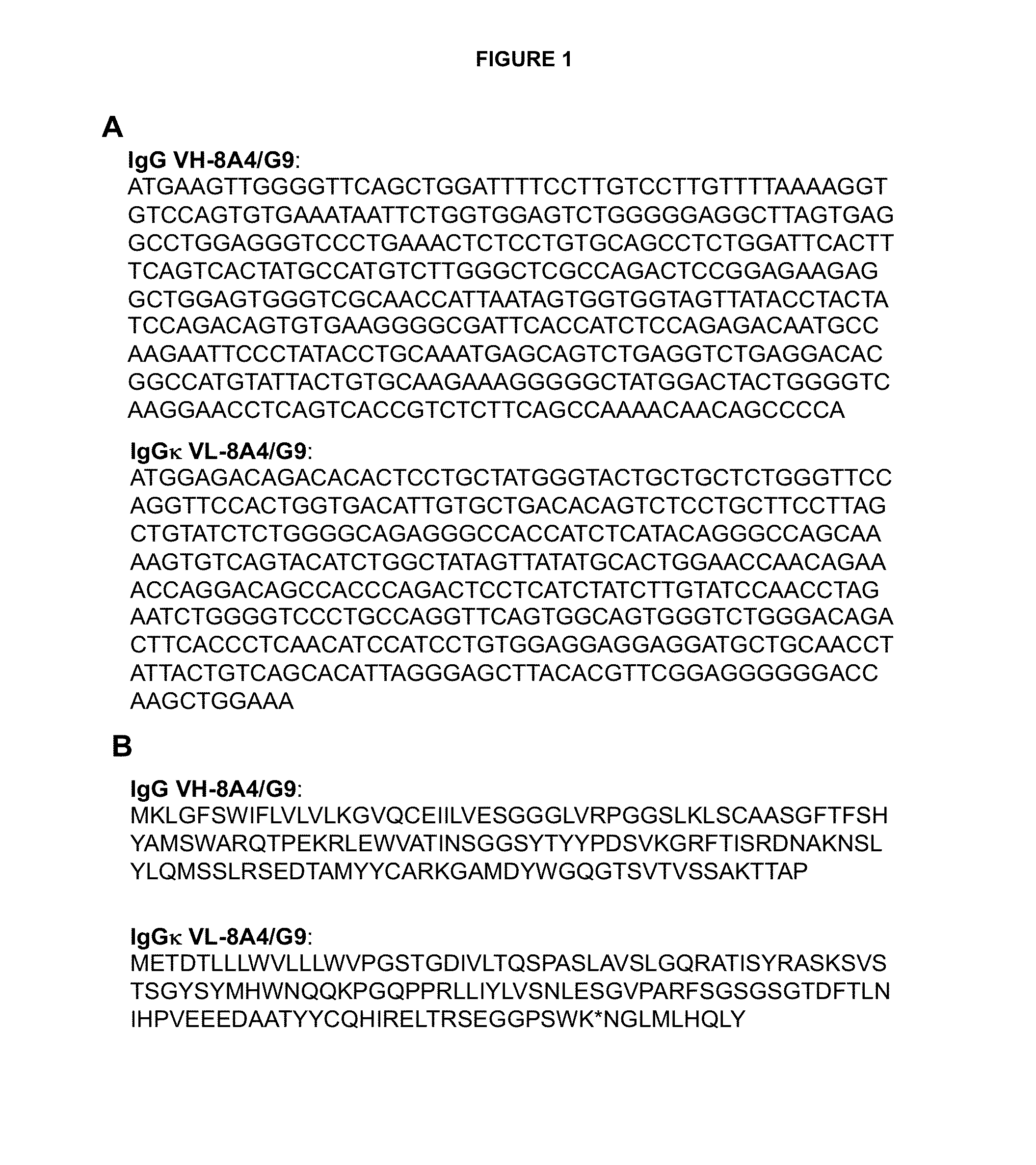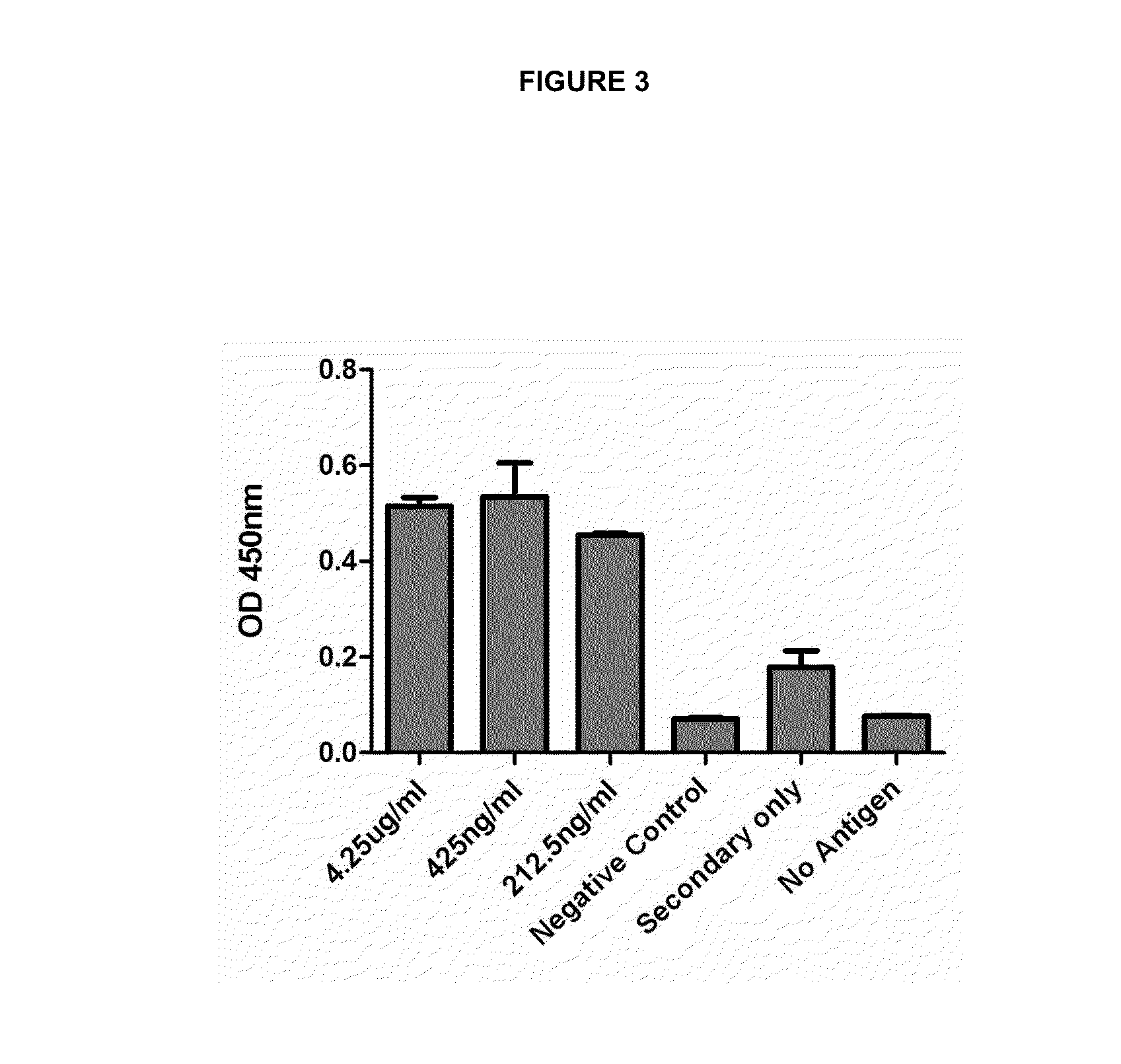Monoclonal antibodies specific for the m2-1 antigen of respiratory syncytial virus (RSV)
- Summary
- Abstract
- Description
- Claims
- Application Information
AI Technical Summary
Benefits of technology
Problems solved by technology
Method used
Image
Examples
example 1
Determination of the Nucleotide Sequence Encoding the Variable Region Light Chain (VL) and Variable Region Heavy Chain (VH) of the Anti M2-1 Immunoglobulin Secreted by the 8A4 / G9 Hybridoma
[0023]8A4 / G9 hybridoma was grown in DMEM-highglucose medium from GIBCO-BRL (Invitrogen, Cat. No.: SH30243.01) supplemented with 3.7 g / L sodium bicarbonate and 10% fetal bovine serum (HyClone) at 37° C. with 10% CO2. When the cell density reached 700,000 cells / ml, 3.5×106 cells were recovered and from these cells a purification of total RNA was performed using Trizol (Invitrogen, Cat No.: 15596-018), as previously described (Chomczynski 1993). 0.5 μg of RNA was retrotranscribed to complementary DNA using the Impron II kit from Promega and 2 μl of the reaction were used to perform a polymerase chain reaction (PCR) using primers supplied in the Ig-Primer set Kit from Novagen (Cat No.: 69831-3) following to suppliers instructions, in a Axygen MaxyGene™ Thermal Cycler. PCR products were obtained with th...
example 2
Detection Assay for RSV Antigens, Specificity of Monoclonal M2-1 Antibody for Purified RSV Antigens
[0024]The objective of this assay is to demonstrate the specificity of our antibody for RSV viral antigens. The antigen detection was carried out by direct ELISA technique, where the ELISA plate was activated with 200 ng of purified antigen for 10 hours at 4° C. After that the plate was washed once with 1× PBS / 0.02% Tween, and twice with 1× PBS, and the plate was then blocked for 2 hours with 1× PBS / 3% BSA at room temperature. The washes were repeated and the plate was then incubated with anti-VRS M2 antibody of 8A4 / G9 clone (425 μg / ml) at a dilution of 1 in 100 in 1× BS / 1% BSA for 2 hours at room temperature. Washes were repeated after the completion of the incubation time and the plate was incubated with an anti-mouse IgG antibody labeled with horseradish peroxidase enzyme (Horseradish peroxidase, HRP) at a dilution of 1 in 2,000 in 1× PBS / 1% BSA for 1 hour at room temperature. Final...
example 3
Assay to Determine the Efficiency of the Monoclonal Antibody to Detect Viral Antigens
[0025]The assay was performed to determine the maximum dilution of monoclonal anti-VRS M2 antibody of 8A4 / G9 clone allowing the detection of viral antigen. For this, we used the same direct ELISA technique of Example 2, but in this case the plate was activated with 100 ng of purified antigen and anti-M2 antibody (425 μg / ml) was used at dilutions of 1 in 100, 1 in 1,000 and 1 in 2,000. The negative control was hMPV M2 protein as antigen, so as to determine that the antibody reaction is specific to RSV antigens and no for antigens of other virus. Controls using secondary antibody alone and no primary antibody were performed for determining that the reaction of the secondary antibody is specific to recognize the primary antibody, and also that the obtained signal is not caused by nonspecific binding of the secondary antibody to the viral antigen. Furthermore, in order to determine that the signal gener...
PUM
 Login to View More
Login to View More Abstract
Description
Claims
Application Information
 Login to View More
Login to View More - R&D
- Intellectual Property
- Life Sciences
- Materials
- Tech Scout
- Unparalleled Data Quality
- Higher Quality Content
- 60% Fewer Hallucinations
Browse by: Latest US Patents, China's latest patents, Technical Efficacy Thesaurus, Application Domain, Technology Topic, Popular Technical Reports.
© 2025 PatSnap. All rights reserved.Legal|Privacy policy|Modern Slavery Act Transparency Statement|Sitemap|About US| Contact US: help@patsnap.com



